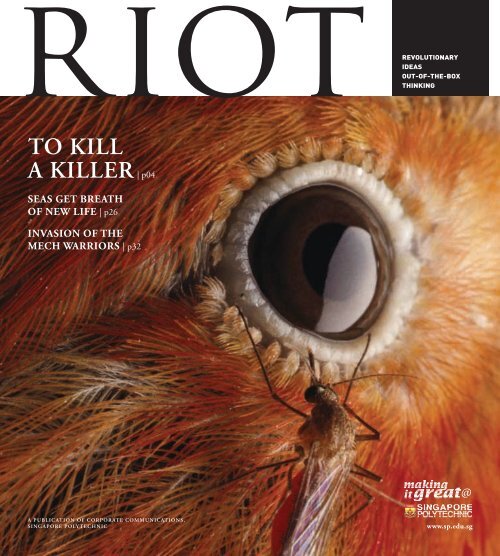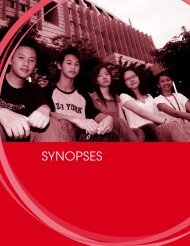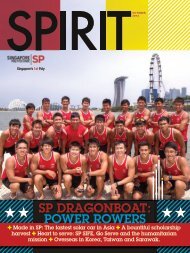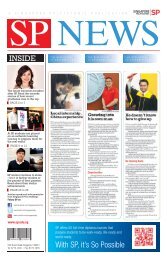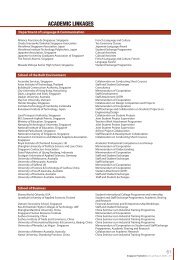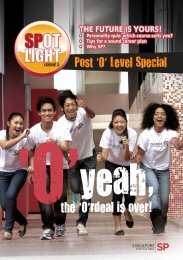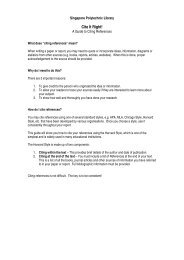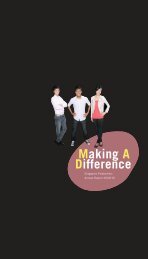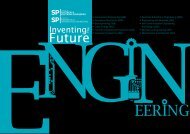Seas get breath of new life - Singapore Polytechnic
Seas get breath of new life - Singapore Polytechnic
Seas get breath of new life - Singapore Polytechnic
- No tags were found...
Create successful ePaper yourself
Turn your PDF publications into a flip-book with our unique Google optimized e-Paper software.
iotREVOLUTIONARYIDEASOUT-OF-THE-BOXTHINKINGTO KILLA KILLER | p04SEAS GET BREATHOF NEW LIFE | p26INVASION OF THEMECH WARRIORS | p32A PUBLICATION OF CORPORATE COMMUNICATIONS,SINGAPORE POLYTECHNICwww.sp.edu.sg
SP Lecturers& StudentsRIOT!The spark <strong>of</strong> innovation.A rush <strong>of</strong> ideas.The result?Creativity unleashed.<strong>Singapore</strong> <strong>Polytechnic</strong> (SP) lecturers and students havebeen firing up their Revolutionary Ideas & Out-<strong>of</strong>-the-boxThinking.Since joining SP, they have freed their minds.There is no turning back.They have transformed into trendsetters.They are charting <strong>new</strong> roads <strong>of</strong> creative evolution.See them make history as they redefine the future.By RIOTing.RIOT 1
iotREVOLUTIONARYIDEASOUT-OF-THE-BOXTHINKINGSINGAPORE POLYTECHNIC500 Dover Road<strong>Singapore</strong> 139651Tel: (65) 6775 1133Fax: (65) 6870 6189Email: ccom@sp.edu.sgwww.sp.edu.sgDesign by atomzAll rights reserved by <strong>Singapore</strong><strong>Polytechnic</strong>.No information herein should bereproduced without the expressed writtenpermission <strong>of</strong> <strong>Singapore</strong> <strong>Polytechnic</strong>.All information correct at time<strong>of</strong> printing.04TO KILL A KILLERWelcome to the world <strong>of</strong> Dr Puah ChumMok—where the relentless search for a cureagainst the dengue and SARS viruses takesplace amidst test tubes, chemical compoundsand supercomputers.12A BRAVE NEW WORLDOF TECHNOLOGY &INNOVATION<strong>Singapore</strong> <strong>Polytechnic</strong> is leading the way ininnovation and applied research at theTechnology and Innovation Centres.16IT’S A DEALSP has taken the industry by storm! Read allabout it here.22PURPLE IS THE NEW GOLDIs all that glitters still gold? Well, abreakthrough process that gives gold apurple tingle says otherwise.26SEAS GET BREATHOF NEW LIFEWire mesh, PVC tubes and a truckload <strong>of</strong>cement and sand have given sea corals atLabrador Park a <strong>new</strong> lease <strong>of</strong> <strong>life</strong>.
32INVASION OFTHE MECH WARRIORSNever mind Manchester United,Real Madrid and AC Milan. Here comes theSP Advanced Robotics Team!36DESIGNED FOR LIFEA look at some <strong>of</strong> the innovations from<strong>Singapore</strong> <strong>Polytechnic</strong>.42PURE (& SINLESS!)INDULGENCEThe future <strong>of</strong> chocolate has inulin in it and doesa whole lot <strong>of</strong> good for your body.46AND THE AWARDS GO TO...Talk about multi-tasking! SP students <strong>get</strong>creative, gain recognition and win awards atthe same time.RIOT 3
perspectiveto kill a killertitle <strong>of</strong> story/descriptionFrom left: Dr Cui Taian,Dr Puah Chum Mok,Dr Liew Oi Wah.4
perspectiveto kill a killertitle <strong>of</strong> story/descriptionAnd here’s the crunch—there is no known cureor vaccine against dengue. You can’t <strong>get</strong> animmunisation jab against dengue, nor can you doseyourself with antibiotics to <strong>get</strong> rid <strong>of</strong> it. Consideringthat the disease was first identified and named in1779, it has survived remarkably well despite theadvent <strong>of</strong> 21 st century medicine. To this day, itremains a virulent health threat in many tropical andsub-tropical countries.But this will not be for long, if all goes well forDr Puah Chum Mok and his team.The biochemist, Centre Director <strong>of</strong> <strong>Singapore</strong><strong>Polytechnic</strong>’s Centre for Biomedical and Life Sciences,is leading his team in a virtual battle against the denguescourge using supercomputers and a technologicalplatform known as VHTS, or Virtual HighThroughout Screening.Instead <strong>of</strong> searching for the elusive cure or vaccinefor dengue, Dr Puah attempted to stop the virus fromreplicating. This, he explained, follows the principlebehind existing treatments for HIV patients, whichtries to modify the virus to stop it from multiplying,thereby controlling the disease. To achieve this,Dr Puah needed to find a chemical compoundthat will modify the dengue NS3 protein, which isresponsible for the virus’ replication.After two years <strong>of</strong> research using a supercomputerto position millions <strong>of</strong> molecular chemicalcompounds into a virtual model <strong>of</strong> the NS3 protein,the team identified not one but 14 chemicalcompounds that could possibly stop the dreadedvirus from replicating.In experiments with cloned specimens <strong>of</strong> the NS3protein, these 14 compounds have successfully bondedwith the protein, thus modifying it and preventing thevirus from replicating. <strong>Singapore</strong> <strong>Polytechnic</strong> has filedfor patents on the 14 chemical compounds.Said Dr Puah modestly, “It is too early to declareour dengue project a success. What we have done s<strong>of</strong>ar is simply to identify some compounds that canpotentially inhibit the activities <strong>of</strong> the viral proteininvolved in the reproduction <strong>of</strong> the virus. This factwas backed up with binding studies using cloned viralproteins. The next stage is to add our compounds ontolive viruses. Only when we see the positive effects onthe viruses do we dare to declare a success, albeit asmall one.”The project’s next ‘live’ stage will see the <strong>Singapore</strong><strong>Polytechnic</strong> team working with an external party.The 14 chemical compounds will be tested on all fourlive strains <strong>of</strong> the dengue virus.Dr Puah revealed that this could take up to twoyears. Only then would the project be ready for thenext phase—animal studies and cell cultures—toensure that the compounds are not toxic to humans.The biochemist admitted that it was early days yet.But he was quietly optimistic about his researchproject. “It takes up to US$1 billion and 10 yearsto develop a drug,” he said. “We are just at the verybeginning <strong>of</strong> a long process.” If Dr Puah’s rounds <strong>of</strong>tests prove successful, the project will likely pass intothe hands <strong>of</strong> any one <strong>of</strong> the large pharmaceuticalswith the financial and technical clout to develop itinto a drug against dengue.As for Dr Puah and his team? They will likely plungestraight into another project, braving unchartedterritories in the nebulous world <strong>of</strong> biochemistry andsearching out other cures.“THE AIM IS TO SPINOFF AND DEVELOP NEWPRODUCTS, PATENTS ANDTECHNOLOGIES.”– Dr Puah6
R IOT 7
perspectiveto kill a killertitle <strong>of</strong> story/descriptionSINGAPORE: A LIFE SCIENCES HUBInstead <strong>of</strong> Internet startups, these days we have biotech startups. The discovery <strong>of</strong>the human genome in 2000 changed the dynamics and economics <strong>of</strong> the biotechindustries and propelled the <strong>life</strong> sciences into international limelight. Indeed, the<strong>life</strong> sciences have become one <strong>of</strong> the most exciting scientific disciplines in the world.For <strong>Singapore</strong>, which is reliant on its human potential as her primary resource, the <strong>life</strong>sciences—with its high-value, capital-intensive requirements—is a perfect investment.Already, the government has put in place various initiatives to promote the islandstateas a <strong>life</strong> sciences hub. This includes a stunning state-<strong>of</strong>-the-art facility aptlynamed Biopolis at One-North. The aim is to make the <strong>life</strong> sciences one <strong>of</strong> the fourpillars <strong>of</strong> the country’s manufacturing sector, after electronics, chemicalsand engineering.<strong>Singapore</strong> <strong>Polytechnic</strong>’s School <strong>of</strong> Chemical and Life Sciences <strong>of</strong>fers several diplomaand advanced diploma courses to provide trained pr<strong>of</strong>essionals for <strong>Singapore</strong>’sbudding <strong>life</strong> sciences industry. Dr Puah elaborates, “Besides training the requiredmanpower for the bio-industry, we can also play a small role in conducting appliedR&D research—i.e. small ‘r’ with big ‘D’.”The big ‘D’ that Dr Puah speaks <strong>of</strong> refers to the development <strong>of</strong> products that canbe licensed to businesses. For instance, the formulation <strong>of</strong> the “Lemonsi Delight”drink which was commercialised by Pokka <strong>Singapore</strong> and the creation <strong>of</strong> a perfumefor 2004 Romancing <strong>Singapore</strong> Festival count as some <strong>of</strong> <strong>Singapore</strong> <strong>Polytechnic</strong>’smore commercial and mainstream <strong>of</strong>ferings. Others include industry-scale projectslike Dr Puah’s dengue research.Says Dr Puah, “The aim is to spin <strong>of</strong>f and develop <strong>new</strong> products, patentsand technologies.”WHEN RESEARCHERS INSHANGHAI SUCCESSFULLYDETERMINED THE STRUCTUREOF THE SEVERE ACUTERESPIRATORY SYNDROME(SARS) PROTEIN, DR PUAH ANDHIS TEAM DECIDED TO APPLYTHEIR METHOD OF RESEARCH INTHE DENGUE PROJECT TO SARS.8
Under the MicroscopeWe probed the mind <strong>of</strong> Dr Puah Chum Mok, Centre Director <strong>of</strong> <strong>Singapore</strong><strong>Polytechnic</strong>’s Centre for Biomedical and Life Sciences, for his thoughts on hischosen discipline, what it takes to be a researcher and <strong>life</strong> beyond the lab.1. What inspired you to go into biochemistry and <strong>life</strong> sciences?Years ago, I read an article on the cracking <strong>of</strong> the DNA codes in a library. Sincethen, I was totally fascinated and intrigued by the fact that genetic materials aremade <strong>of</strong> chemical blocks and nothing else.2. How long have you been in this discipline? Did you ever think<strong>of</strong> switching fields?It’s been too long to remember! Although many <strong>of</strong> my colleagues have switchedfields into sectors that are more financially lucrative, I firmly believe in whatI am doing, because the type <strong>of</strong> work we are doing can make a difference inimproving our general healthcare and education.3. If not academia and research, which pr<strong>of</strong>ession would youhave gone into?I nearly went into accountancy. It was just that the job <strong>of</strong>fer from a hospitalarrived through the post before the accounting firm.4. What is the most satisfying moment for you in the course <strong>of</strong>your illustrious career?I wouldn’t dare to say that my career is illustrious or even glamorous. Theseterms rightfully belong to other pr<strong>of</strong>essions and certainly do not apply to those<strong>of</strong> us labouring in the labs. The only buzz you <strong>get</strong> out <strong>of</strong> this is when you findsomething <strong>new</strong> in what you are doing and it is <strong>of</strong> commercial value.5. You taught for some time before moving back into research.What was the greatest challenge you faced as a teacher?I started <strong>of</strong>f in endocrine research and moved into the bio-industry culturingHIV and other viruses before entering the teaching world. And now it is backto research. In the research arena, everyone is a student because you will beasking questions all the time. But our students tend to clam up. That will bethe biggest problem if they want to <strong>get</strong> into research. In R&D, you must askquestions and ponder—very <strong>of</strong>ten, the right questions can trigger <strong>of</strong>f usefulinsights and even provide the solutions to your problems.6. What was the greatest challenge you faced in research?To <strong>get</strong> people to talk more <strong>of</strong>ten about their work so that others may <strong>of</strong>fertips to solve their problems. The other problem is <strong>get</strong>ting the right peopleor partner to work with you. Ultimately, we have to rely on each other’sstrengths to overcome the many problems we are facing. You can’t work byyourself in isolation.7. What does it take to be a successful researcher?You must have a gut feel for the project even if it has only a 55% chance <strong>of</strong>succeeding. This means you must stick your neck out to take some risks. Otherattributes such as perseverance, tenacity and having a ‘thick skin’ in facing upto many doubters will come in handy.8. Describe your research philosophy or ethics.Once we <strong>get</strong> the right people, we must let them work at their own pace.We should not look over their shoulders all the time or <strong>breath</strong>e down theirnecks at every setback. But that does not mean we do not have to account forthe outcomes at the end <strong>of</strong> each project. Ultimately, it is taxpayers’ monies thatare financing the projects.9. <strong>Singapore</strong> is positioning itself as a hub for the <strong>life</strong> sciences.In your opinion, what more can be done by the authorities toestablish this?What we are trying to do is to show that besides training the requiredmanpower for the bio-industry, polytechnics can play a small role inconducting applied R&D research i.e. a small ‘r’ with big ‘D’. Many <strong>of</strong> ourprojects are with the academia—while they concentrate on the upstream aspect,we work on the downstream. Typically, this is the stage where prototypes aredeveloped and evaluated, and will be <strong>of</strong> interest to potential investors who wantto commercialise them. Since our work generates Intellectual Property Rights,we have no choice but to file for patents. That inevitably involves filing costs.Furthermore, some form <strong>of</strong> support to help us in recruiting staff would be atremendous help.10. What is your <strong>life</strong> like outside the lab?Tai chi is my other interest. I have been doing it for the last 17 years. It mayappear to the uninitiated as nothing more than waving one’s arms around.I myself was initially surprised by the amount <strong>of</strong> thinking one has to do toperfect tai chi moves. To me, it is more difficult to do tai chi than to doanother ten PhDs. To overcome the mental blocks, one has to read old tai chimanuals, which are <strong>of</strong>ten written in an obfuscated language. The other booksthat I read many times to improve my tai chi and research are the Dao Te Jingand the Yi Jing. Incidentally, these ancient texts have attracted the attention <strong>of</strong>researchers working in areas <strong>of</strong> particle physics and those who want to knowwhat the universe is made <strong>of</strong>.11. Who are the other members on your team for thedengue research?Pr<strong>of</strong>essor Zhu Weiliang was with us for six years and he was instrumental in<strong>get</strong>ting the dengue project <strong>of</strong>f the ground. Although he is back at the ShanghaiInstitute <strong>of</strong> Materia Medica as a principal investigator, we still collaborate onour dengue and SARS projects. Recently, Dr Chen Gang and Dr Zuo Zhilijoined us to speed up our projects. Internally, Dr Liew Oi Wah helped us toclone the viral proteins. And Dr Cui Taian designed the anti-viral peptides.R IOT 9
“Prpassioch10
ogressis achievedby thenatewho dare toange.”RIOT 11
perspectivea brave <strong>new</strong> world title <strong>of</strong> technology <strong>of</strong> story/description & innovationA BraveNew World <strong>of</strong>Technology&Innovation12
Progressive Hothouse, Incubators, R&D Hub, Catalyst,Creative Dynamos… whatever you call them, theTechnology and Innovation Centres at <strong>Singapore</strong><strong>Polytechnic</strong> are earning wide acclaim locally and globally.What’s more, they have inspired students and staff toscale greater heights in creativity and innovation.TECHNOLOGY AND INNOVATIONCENTRES: A MOTHER LODE OFCREATIVE IDEASA fertile ground for future technology, products and processes,the Technology and Innovation Centres (TICs) in <strong>Singapore</strong><strong>Polytechnic</strong> (SP) are where knowledge creators and ideasgenerators come to<strong>get</strong>her with compelling effect.These multi-disciplinary centres provide research facilities forstudents to explore their potential, and staff to keep abreast <strong>of</strong>the latest developments in the industry. In turn, they enhancethe quality <strong>of</strong> teaching in SP and streamline the transfer <strong>of</strong>technology to and from the industry.Highly attuned to the latest industry trends, expertise at theTICs revolves around the following areas:• Biomedical and Life Sciences• Environmental Applications• Experience Design• Food and Beverage• Interactive and Digital MediaBesides <strong>of</strong>fering an excellent platform for staff and students toengage in high-tech research, the TICs are also launch pads formajor industrial collaborations and cutting-edge R&D projects.R IOT 13
perspectivea brave <strong>new</strong> world title <strong>of</strong> technology <strong>of</strong> story/description & innovationR&D FOR COMMUNITYCommitted to transferring the advantages <strong>of</strong> R&D to thecommunity, the TICs place an emphasis on commercialresults for public benefits.The TICs regularly engage external partners and thecommunity in its research—to achieve mutually beneficialoutcomes. Staff at the TICs are also actively involvedin developing a range <strong>of</strong> joint projects with privateorganisations and companies.On the other hand, TICs like the Centre for Applicationsin Environmental Technology, and Food Innovation andResource Centre work closely with government agenciesto develop innovative products. These agencies includeSPRING <strong>Singapore</strong>, PUB and EDB.TO INFINITY AND BEYONDFor the future, SP aims to build <strong>new</strong> TICs in thefollowing areas:• Bioengineering• Business Innovations• Creative Teaching• Manufacturing Technology• Maritime Transportation• NanotechnologyWith their sights set on technology development anda sharp focus on future innovations, TICs in SP wouldprovide the essential support to benefit the economicdevelopment <strong>of</strong> <strong>Singapore</strong> in years to come.CENTRE FORAPPLICATIONS INENVIRONMENTALTECHNOLOGY (CAET)The CAET aims to lead thedevelopment <strong>of</strong> application inenvironmental technology. Thecentre works closely with nationalagencies, enterprises, and institutionsto carry out R&D in this area. Suchpartnerships serve to be beneficial for<strong>Singapore</strong> as a whole.MissionTo support local R&D and innovationin the environment and water industry.R&D Focus• Clean water management• Clean air management• Noise management• Solid waste management• Sensing Technology• Waste reduction, recyclingand reuse• Nature/resource conservation• Green and clean technologiesInnovation Highlights• Creative use <strong>of</strong> composite wood• Waste water qualitymonitoring system• Waste Concrete Reclamation• Sustainable & Clean Energy• Air Pollution & Control MeasuresContactCentre for Applications inEnvironmental TechnologyW1011LT: +65 6870 4857 F: +65 6870 704814
CENTRE FORBIOMEDICAL AND LIFESCIENCES (CBLS)CENTRE FOREXPERIENCE DESIGN(CXD)FOOD INNOVATIONAND RESOURCECENTRE (FIRC)INTERACTIVE ANDDIGITAL MEDIACENTRE (IDMC)At the forefront <strong>of</strong> living organismstudies, the CBLS is fully equippedwith state-<strong>of</strong>-the-art laboratoryfacilities. With the ability to adaptto rapid changes in the industry, theCBLS supports SP’s excellent trainingon high-tech development in <strong>life</strong>sciences. The centre also aims to spurstudents’ creative exploration inthis field.MissionTo develop a vibrant applied R&Dculture and support technologydevelopment in <strong>life</strong> sciences.R&D Focus• Bioengineering• Bimolecular modelling• Transgenic plants• Bioprocess engineering• Drug design and screeningInnovation Highlights• Optical sensing for detection <strong>of</strong>plant nutrients and water stress• Identification <strong>of</strong> 14 compoundsto prevent the dengue virus fromreplicating• Anti-SARS compoundContactCentre for Biomedical and LifeSciencesT11A Level 4T: +65 6772 1896 F: +65 6870 8004The latest research facility in SP, theCXD conducts Applied Researchand Innovation (ARI) in ExperienceDesign. Experience Design is theconvergence <strong>of</strong> Design, Innovation,Technology and Business to createa sustainable competitive advanta<strong>get</strong>hat is vital in the global product valuechain. The centre also runs the IDEA(Innovation, Design & Enterprise inAction) module, a subject that buildscreative capital and nurtures a culture<strong>of</strong> creativity, innovation and enterpriseamong the staff and students.MissionTo create original, unique, memorableand transformative experiences <strong>of</strong>products, services and brands aspremium economic <strong>of</strong>ferings.R&D Focus• Customer experience design• Experience interface design• Sensory BrandingContactCentre for Experience DesignT11A 203T: +65 6870 7971 F: +65 6870 7051The FIRC is a joint initiative by SPRING<strong>Singapore</strong> and <strong>Singapore</strong> <strong>Polytechnic</strong>.The centre, being the first centre <strong>of</strong>innovation to be launched underSPRING, will help food enterprises todevelop <strong>new</strong> and innovative products,processes and packaging.MissionTo be a one-stop technology andresource centre for food enterprises.Services• Consultancy Services inTechnology Development• Training Courses, Seminars& Workshops• Innovation Resource &Advisory Support• Equipment & Test Kitchen for hireInnovation Highlights• Formulation <strong>of</strong> twin-plynoodles, functional inulin-infusedchocolates, reduced sugar ‘XO’ kaya.• Processing and packaging <strong>of</strong>microwaveable, “ready-to-eat”frozen meals such as Hainanesechicken rice, Laksa, and “Dry”Mee Pok.ContactFood Innovation and Resource CentreW214T: +65 6870 0634 F: +65 6870 8024The IDMC was established in line withnational efforts to promote R&D inInteractive and Digital Media (IDM),and advance the growth <strong>of</strong> the IDMindustry in <strong>Singapore</strong>. The centreadopts a cross-disciplinary approachby bringing to<strong>get</strong>her the domains <strong>of</strong>interactive and digital media, infocommunications,engineering, business,music, architecture, and design.MissionTo support <strong>Singapore</strong>’s R&D andinnovation in the Interactive andDigital Media Industry.R&D Focus• IDM in education• Human-Computer Interactive(HCI) for music and the arts• Computer games and digitalentertainment technology• Digital graphic and effects• Immersive environments andmetaverse (virtual reality)Innovation Highlights• Digital Media Gridzone (DMG)The DMG is a cost effectiverendering farm assembled usingcommodity PC hardware ands<strong>of</strong>tware. It accelerates the process<strong>of</strong> rendering complex digital scenesby parallel process.ContactInteractive and Digital Media CentreT2042T: +65 6870 4735 F: +65 6779 7912R IOT 15
perspectiveit’s a dealtitle <strong>of</strong> story/descriptionit’s a deal<strong>Singapore</strong> <strong>Polytechnic</strong> has made a name foritself, not only within the educational arena, butin the commercial world as well. Here we takea look at some <strong>of</strong> the students’ efforts that havemade it to the big time.1Quest for Healthy Kaya13Fong Yit Kaya engages <strong>Singapore</strong> <strong>Polytechnic</strong>students to develop a healthier breakfast option.Fong Yit Kaya enlisted <strong>Singapore</strong> <strong>Polytechnic</strong> on a missionthat would revolutionise breakfast forever: to create ahealthy version <strong>of</strong> kaya, the traditional coconut and eggspread. Goh Tee We, Production Manager at Fong YitKaya, said the reason he chose to partner SP was because<strong>of</strong> its expertise in R&D.426In 2006, <strong>Singapore</strong> <strong>Polytechnic</strong> was proud to say “Missionaccomplished!” to the leading kaya manufacturer.Final-year students from the Diploma in ChemicalProcess Technology, Food Technology option, had createdan authentic kaya with about 25% less sugar, fat andcholesterol and yet retains the familiar rich taste. It wasawarded the Healthier Choice label by the <strong>Singapore</strong>Health Promotion Board.The great tasting, smooth-textured and healthier version<strong>of</strong> kaya is now available on supermarket shelves.75816
2 3 4Authentic Local Meals at the Push<strong>of</strong> a ButtonRice that’s a Runaway SuccessUsing Their NoodlesPartnering <strong>Singapore</strong> Food DelightManufacturer to create a range <strong>of</strong> frozen readyto-eatmeals.<strong>Singapore</strong> <strong>Polytechnic</strong> and <strong>Singapore</strong> Food DelightManufacturer wanted to make favourite dishes convenientlyavailable to all busy households.In the end, SP managed to package seven local favourites intostate-<strong>of</strong>-the-art packages that do not even require puncturingduring microwaving. These seven were Soya Sauce ChickenRice, Curry Chicken Rice, Hainanese Chicken Rice, ChilliCrab, Pepper Crab, Laksa and Mee Pok Dry.Unlike usual frozen foods, the innovative packaging doesnot require consumers to puncture or peel <strong>of</strong>f the clear filmbefore heating in a microwave. Instead, the vacuum-skin film“balloons up”, trapping moisture and flavour as it is heated,and then self vents and relaxes over the food.SP provided expertise in the formulation, processing andpackaging <strong>of</strong> the products.Gan Hup Lee to market special flavouredsavoury rice across Asia and Europe.During their internship with local rice supplier Gan HupLee, two <strong>Singapore</strong> <strong>Polytechnic</strong> students concocted a creationthat made it possible for busy individuals to whip up some <strong>of</strong>their favourite dishes in under 20 minutes.The students developed special flavoured savoury ricepremixed with natural flavours and other ingredients to createDish Out Ready-to-Cook Chicken Rice, Nasi Lemak, MixedBrown Rice with Garlic and Yam, and Mixed Brown Ricewith Anchovies.Gan Hup Lee plans to export Yamie Rice across Asia andEurope, where it sees a huge potential market. Meanwhile,the two <strong>Singapore</strong> <strong>Polytechnic</strong> students are already workingon a low-fat, calcium-fortified version <strong>of</strong> Yamie Rice to caterto the health-conscious.Kwong Seng International manufacturesrevolutionary two-taste noodles.As part <strong>of</strong> their final-year project, three <strong>Singapore</strong> <strong>Polytechnic</strong>students created a range <strong>of</strong> unusual two-ply noodles with tw<strong>of</strong>lavours that have been snapped up by <strong>Singapore</strong>’s leadingnoodle manufacturer, Kwong Seng International.The unique noodles are made from a combination <strong>of</strong>Spinach/Paprika, Soy/Pumpkin and Sesame/Pandan—allingredients starting with the letters “S” and “P”. The noodlesdo not contain any artificial flavouring or preservatives andhave received halal certification from Majlis Ugama IslamSingapura. The noodles are a part <strong>of</strong> the Premium Food Gifts<strong>of</strong> <strong>Singapore</strong> and are sold at Changi Airport Terminal 1.It has also won the <strong>Singapore</strong> Institute <strong>of</strong> Food Science andTechnology’s Innovation Award 2005-2007.R IOT 17
perspectiveit’s a dealtitle <strong>of</strong> story/description5 6 LapGetting Saucy in <strong>Singapore</strong>Sweet Twist to Spice up YourRomance7Cheong Gets Healthy Boost withLower Fat and Sodium ContentLocal student-developed condimentgives foreign salad dressings a run fortheir money.Everyone’s heard <strong>of</strong> Thousand Island, French and Italian saladdressings. But one would be hard pressed to find a truly Asianor <strong>Singapore</strong>an condiment in the supermarkets. However,with the efforts <strong>of</strong> <strong>Singapore</strong> <strong>Polytechnic</strong>, RevoPack andFountainhead Manufacturing, the <strong>Singapore</strong> Salad Sauce hasbecome a reality.Combining spices found in the region, the halal-certifiedsauce was fine-tuned for five months by a trio <strong>of</strong> FoodTechnology graduates from the polytechnic’s School <strong>of</strong>Chemical and Life Sciences. Available in both Spicy andFusion flavours, the sauce is suitable as a salad dressing,marinade, for barbeques, stir-fries and even spaghetti.For a start, the <strong>Singapore</strong> Salad Sauce was available atVantage Gourmet’s <strong>Singapore</strong> Premium Food Gift BoutiqueCafé at Changi Airport from July 2007 and subsequently inCold Storage Supermarkets.With a shelf-<strong>life</strong> <strong>of</strong> at least one year without refrigeration,the sauce is set to spice up the menus <strong>of</strong> tourists and<strong>Singapore</strong>ans.<strong>Singapore</strong>ans express their love with chocolateandcheese-filled curry puffs!This novelty item, which looks like a traditional curry puffcomplete with a crispy exterior, was sold by 1A Crispy Puffsat its 10 outlets across the island. The puffs were packed inspecially designed gift boxes for the romantic touch.This Valentine’s Day recipe was whipped up by three former<strong>Singapore</strong> <strong>Polytechnic</strong> students.Ms Tracy Ow, 24, Project Manager <strong>of</strong> 1A Crispy Puffs, whichis owned by her family, sampled and fell in love with therecipe during <strong>Singapore</strong> <strong>Polytechnic</strong>’s Spinnovex Exhibition.This exhibition showcases the projects <strong>of</strong> final year students.“Puffs are generally shared with family and friends. We havejust added love and passion into every bite. So instead <strong>of</strong>buying a box <strong>of</strong> chocolates, you can buy a box <strong>of</strong> Valentine’sDay puffs for your dear ones. The best way to eat thesenovelty puffs is to bite into them,” says Tracy, “letting thechocolate and cheese ooze out and melt in your mouth.”Lovers <strong>of</strong> Chinese sausages, or lap cheong,can now savour this delight without worryingabout clogged arteries.<strong>Singapore</strong> <strong>Polytechnic</strong> students have developed a lap cheongwith lower fat and salt content. Their creation even meetsthe nutritional guidelines <strong>of</strong> the Healthier Choice LabelProgramme administered by the Health Promotion Board!Golden Glory Food Industries, which has been producingsausages for 30 years, signed a two-year agreementwith <strong>Singapore</strong> <strong>Polytechnic</strong> to manufacture and marketthese healthier sausages, under the brand name TwinzSausage D’lite.The company has approached supermarket chains to marketTwinz Sausage D’lite within <strong>Singapore</strong>. It is also eyeing theMalaysian and Australian markets.18
9108Local Chocolate Entrepreneur Wantsa Bite <strong>of</strong> Global Halal Market9Another Winning Collaborationwith Industry10Cosmetical Asia Markets PerfumesCreated by SPMuslims here and abroad have a <strong>new</strong> line <strong>of</strong>high-end chocolates to savour.Board games are child’s play for theseSP students.Romance <strong>Singapore</strong> sees brisk sales.Cacao Gourmet & Premiums is embarking on a <strong>new</strong> ventureto manufacture and market inulin-infused chocolatesdeveloped by <strong>Singapore</strong> <strong>Polytechnic</strong>. Inulin is a plant fibrethat helps promote the growth <strong>of</strong> good bacteria in theintestines and improve digestion. With this product, not onlycan Muslim consumers enjoy the pleasures <strong>of</strong> chocolate, butthey can also benefit from its healthy goodness at thesame time.The company has received halal certification from MajlisUgama Islam Singapura (MUIS) for this inulin-infusedchocolate line. The chocolates’ main ingredients include fruitpuree and inulin, making them suitable for Muslimsto consume.Cacao Gourmet & Premiums is distributing the chocolatesthrough gourmet chocolate boutiques here, before moving totap the vast affluent Muslim consumer markets in the region,the Middle-East and beyond.<strong>Singapore</strong> <strong>Polytechnic</strong>’s School <strong>of</strong> Media and Info-Communications Technology signed a Memorandum <strong>of</strong>Cooperation with local company Alpha-Plus Training in2006. The aim was to develop and commercialise boardgames that would address the needs <strong>of</strong> the corporate world.It started with a student-developed game called Manage,Manage, Manage.Students came up with another innovative board game,which was further evolved and fine-tuned by Alpha-PlusTraining and named ProjeX.This integrated learning experience draws on the latestcutting-edge brain research and calls for effective teamwork.It highlights the value <strong>of</strong> different roles and motivations tocomplete a project on time, within bud<strong>get</strong> and with quality.Alpha-Plus Training has bought over the remaining rights tothe game to be able to sell it commercially.When nine students from <strong>Singapore</strong> <strong>Polytechnic</strong>’s School<strong>of</strong> Chemical and Life Sciences created two perfumes for anational campaign called Romance <strong>Singapore</strong> 2004, they seta milestone in the local fragrance industry.The two perfumes are the first <strong>Singapore</strong>an perfumes createdby students to be commercialised.The students experimented with a hundred different types <strong>of</strong>scents before discovering the perfect two perfumes. The resultis a sensual mix <strong>of</strong> freshly picked flowers for the ladies and amusky, seductive blend for the men.In 2004, Cosmetical Asia signed an agreement with SP tolaunch the Romance <strong>Singapore</strong> perfumes. To date about6,000 bottles <strong>of</strong> the perfumes have been sold.The success <strong>of</strong> the perfumes led to the signing <strong>of</strong> anotheragreement with Cosmetical Asia/StarAsia in March 2007 tomanufacture and sell a <strong>new</strong> series <strong>of</strong> perfumes for malesand females.R IOT 19
perspectivetitle <strong>of</strong> story/descriptionInnovatioinspiEnterpris20
nreseR IOT 21
perspectivepurple is the <strong>new</strong> gold title <strong>of</strong> story/description22
Purpleis theNEWGOLDNeed pro<strong>of</strong> that R&D is not just an esoteric processthat’s confined to the lab? The discovery <strong>of</strong> purple goldshows that it can literally be turned to gold.GOLD—GLITTERING, PRECIOUS GOLDNo other substance has quite captured the human imagination and engendered fascination asmuch as gold. Throughout the ages, it has caused the madness <strong>of</strong> gold rushes, held steadfast invalue through world turmoil, adorned the powerful and inspired millions.The glamour and mystery <strong>of</strong> gold has inspired the best scientists and alchemists to try their handat making it. It’s an irresistible possibility that could transform anyone into a King Midas—the idea that, through hours in the lab, you could find a secret formula to create the world’smost highly coveted and enduring form <strong>of</strong> wealth.Now combine that allure with the colour purple—a mystical colour <strong>of</strong> individualityand, in the West, <strong>of</strong> royalty—and you will see the appeal <strong>of</strong> purple gold for MrLoh Peng Chum. He perfected a process to produce malleable and stable purplegold while he was a lecturer in the School <strong>of</strong> Mechanical and ManufacturingEngineering at <strong>Singapore</strong> <strong>Polytechnic</strong>.Mr Loh Peng ChumR IOT 23
perspectivepurple is the <strong>new</strong> gold title <strong>of</strong> story/descriptionMr Loh Peng Chum perfecting the technique to makemalleable , stable purple gold in the laboratory.“IT TOOK ME THREE YEARS OFEXPERIMENTING TO IMPROVETHE PROCESS SO THAT THE YIELDREACHED 80 PER CENT INSTEADOF THE INITIAL 20. BUT WHATKEPT ME GOING WAS THE DESIRETO MAKE MY IDEA HAPPEN.”– Mr LohTURNING PURPLEMr Loh’s journey towards purple gold beganin 1976, when his lecturer at the University<strong>of</strong> Wisconsin challenged him to find a way tostabilise purple gold. It was only some 24 yearslater, in 2000, that he finally managed to createthe world’s first 19-carat lilac-coloured gold.“At that time, purple gold had already beenaround for at least 20 years,” he recalled. “Buta way to produce it in a pure, untarnished formthat was malleable enough to turn into jewelleryhadn’t yet been found.”The alloy <strong>of</strong> gold and aluminium was brittle, porousand reacted too readily, even to oxygen in the air,leading to blotches and uneven colouration.It took Mr Loh two years <strong>of</strong> dedicated work andsacrifices—19-hour work days, weekends, and theoccasional accident in the lab—to develop a methodthat turned out a malleable, stable purple gold.“My technique involves heating the mixture <strong>of</strong>gold and aluminium to 10,000 degrees Celsius,then passing an electrical current through themolten alloy,” he explained. Naturally, the workhazards were very real—10,000 degrees Celsius ishotter than the surface <strong>of</strong> the sun. Mr Loh evenrecalled an incident when a chemical explodedand his torso and shoulder were severely scalded.And even after the gold had been developed,the work wasn’t over. “After Aspial CorporationLimited bought the marketing rights to purplegold in 2000, I had to work with them to findways to make the metal more commerciallyviable,” he said.It’s a process that he remembered as being evenmore challenging than the first two years, “Ittook three years <strong>of</strong> experimenting to improvethe process so that the yield reached 80 per centinstead <strong>of</strong> the initial 20. But what kept me goingwas the desire to make my idea happen.”24
GOLD RUSH!For jeweller Aspial Coporation Limited, the discovery wasliterally like striking gold. “We decided to buy the rightsbecause we recognised the potential <strong>of</strong> purple gold andthe positive impact it would have on our brand names andpr<strong>of</strong>it,” explained Mr Kean Ng, Senior Marketing Manager<strong>of</strong> Lee Hwa Jewellery.“It was an industry breakthrough since we’ve always hadwhite gold, yellow gold and rose gold. Purple was a verydifferent and unique colour.”Consumers were quick to catch on to the uniqueness <strong>of</strong>Aspial’s purple gold range. “Purple gold was a major hitwhen it was first launched in <strong>Singapore</strong>—consumers lovedit,” recalled Mr Ng.Apart from the overwhelming market response, Mr Loh’sinvention also helped to put <strong>Singapore</strong> on the map, andushered Aspial onto the international market scene. “We’vehad many international enquiries regarding our purple goldand we’ve also exported some limited pieces to exclusiveoverseas jewellers,” said Mr Ng.For Mr Loh, who has since retired from <strong>Singapore</strong><strong>Polytechnic</strong> after 32 years with the institution, the work goeson too. It’s pushing the boundaries <strong>of</strong> the precious metalthat Mr Loh is most passionate about—and his passionfor the metal shows no sign <strong>of</strong> waning. When asked why,he laughed and said it could be because his name means“three gold” in Cantonese. “My father chose it for me as myChinese elemental analysis found I was lacking in gold.”“Its appeal is definitely its uniqueness—most people weresurprised to know that purple gold actually existed. It’salways a conversation starter, especially if you tell peoplewho’ve never seen or heard about it before.”“MY TECHNIQUE INVOLVES HEATINGTHE MIXTURE OF GOLD ANDALUMINIUM TO 10,000 DEGREES CELSIUS,THEN PASSING AN ELECTRICAL CURRENTTHROUGH THE MOLTEN ALLOY.”– Mr LohR IOT 25
perspectiveseas <strong>get</strong> <strong>breath</strong> <strong>of</strong> <strong>new</strong> title <strong>life</strong> <strong>of</strong> story/descriptionA day in the <strong>life</strong> <strong>of</strong> a marineconservationist: Bravingthe elements.26
“YOU’RE CREATINGSOMETHING OUT OFNOTHING TO RESTORE THEENVIRONMENT”– Captain Francis<strong>Seas</strong> Get Breath<strong>of</strong>NEW LIFEUsing simple materials to create artificial reefs, a team <strong>of</strong> marineenthusiasts show that restoring <strong>Singapore</strong>’s dwindling corals is goodnot only for the sea, but for the soul as well.It started as an idea in marine conservation. A Seacil is,admittedly, a rather innocuous-looking structure. It consists<strong>of</strong> a wire frame with mesh screens, supported on PVC pipes.A mixture <strong>of</strong> cement, sand and seawater is poured into bagswhen the Seacil is underwater, to form a concrete edifice onwhich corals can grow. The humble appearance <strong>of</strong> a Seacilbelies what it is built to accomplish: the regeneration <strong>of</strong> coralreefs where they have been largely destroyed or damaged.After many frustrating years <strong>of</strong> trying to <strong>get</strong> it done, it wasmade a reality when commercial diver Charles Rowe teamedup with the <strong>Singapore</strong> Maritime Academy. There it becamean R&D project that has gained recognition locally.Lowered into relatively shallow waters—onto PVC pipesto prevent it from sinking into the mud—the Seacil’s meshscreen, made from fishing nets, filters out sediments thatimpede coral growth. Its concrete face is positioned at a 45°angle to the waves, to break the force <strong>of</strong> the current. Natureis thus given a slight leg up.CORAL REEF DAMAGE—THE GRIM FACTSAround the world, coral reefs have been battling for survival. A 2001report by GESAMP warned that “coral reefs have been damaged in93 <strong>of</strong> the 110 countries where they occur, and some 27% <strong>of</strong> the world’sreefs run a high risk <strong>of</strong> degradation.”Locally, the National University <strong>of</strong> <strong>Singapore</strong> Reef Ecology Study Teamnoted that “since 1986, most coral reefs in <strong>Singapore</strong> have lost up to65% <strong>of</strong> their live coral cover”.THE RISE OF AN UNDERWATER WORLDThe team was upbeat about what they could achieve at Labrador Park, which is aprotected heritage site.“We’re lucky to have this place. NParks has sponsored the container where the team has setup a temporary site <strong>of</strong>fice. The Totalisator Board has given us $145,000 <strong>of</strong> funding. I don’tperceive this project to be one hundred per cent, but I think there will be a level <strong>of</strong> success,”said Rowe.For Captain Frederick Francis, the leader <strong>of</strong> the project, one <strong>of</strong> the mostrewarding aspects <strong>of</strong> the project was “working with the students and creating inthem an awareness <strong>of</strong> the marine environment.” He explained, “Often, they don’tknow about all the wonderful corals you can find in <strong>Singapore</strong>…the students willbe the future stakeholders, and we have to pass on the importance<strong>of</strong> sustainability.”But this is just the beginning.Captain Francis’ vision is to see a marine environmental centre built at LabradorPark, so they could give talks to the public and educate them.He elaborated, “The technology used in the Seacil project can be used not only in<strong>Singapore</strong> but in other countries in the Asia Pacific as well. In the long run, thiswould help to establish <strong>Singapore</strong>’s status in marine conservation.”“It’s a responsibility we have to the marine environment.”The plan is for a series <strong>of</strong> these artificial reefs to be set up, complete with corals,clownfish, and a whole host <strong>of</strong> other aquatic <strong>life</strong> forms. As Captain FrederickFrancis puts it, “We are not just creating Seacils, but an underwater garden.”R IOT 27
perspectiveseas <strong>get</strong> <strong>breath</strong> <strong>of</strong> <strong>new</strong> title <strong>life</strong> <strong>of</strong> story/descriptionCoral reefs play a critical role in the marine environment. In alecture on the Seacil project, Captain Francis described themas “the rainforests <strong>of</strong> the sea”, an apt description for some <strong>of</strong>the oldest and most complex ecosystems in the world.Their significant socioeconomic function is highlighted inthe GESAMP (the Joint Group <strong>of</strong> Experts on the ScientificAspects <strong>of</strong> Marine Environmental Protection) report: “Coralreefs have supported human populations on tropical coasts<strong>of</strong> the world for hundreds, if not thousands, <strong>of</strong> years.”Their great biological diversity makes them a storehouse <strong>of</strong>“organisms that are a source <strong>of</strong> chemicals with potentiallyhigh commercial value”.Said Larry Chua, a student research assistant on the projectteam then, “According to the older folks, you could findcorals around Pulau Hantu and even nicer ones here atLabrador about thirty years ago. Now, they are slowly beingkilled by sedimentation and marine movements.”Coral theft, too, is putting <strong>Singapore</strong>’s myriad—there areabout 200 species <strong>of</strong> hard corals found in our waters—coralpopulations at risk. This has led to the formation <strong>of</strong> groupslike the Labrador Park Watch, whose members patrol thebeaches to deter poachers.But there is evidence that sometimes it is more pr<strong>of</strong>itable towork with nature than against it. Coral reefs are, after all, amajor tourist attraction. Up to 1.6 million tourists descendupon the Great Barrier Reef each year to admire the sublimeunderwater seascape, generating in the process over $1billion in tourist revenue.Little wonder, then, that Rowe envisioned the completedSeacil project at Labrador Park as an underwater gardenattraction. Solar-powered underwater lights installed on theseacils serve not only an aesthetic purpose, but also attractmarine <strong>life</strong> at night.Marine conservation does not have to be at odds witheconomic development, nor does it have to involveextremely high costs or state-<strong>of</strong>-the-art materials.Rowe pointed out, “We’re reusing elements <strong>of</strong> the sea, likesaltwater and sand. All we’re adding is the gluing nature <strong>of</strong>cement to create something that is recyclable...you’re creatingsomething out <strong>of</strong> nothing to restore the environment.”The Seacil project is aimed at preserving coral <strong>life</strong>forms(pictured) that are found in <strong>Singapore</strong>an waters.Fully loaded, and ready tosave the underwater world.28
“WE TAKE CORALS,AND WE GRAFT THEBASE OF THE CORALSONTO THE CONCRETEEDIFICE. AND THEREYOU HAVE IT—NATURE, WITH ITSOWN APTITUDE TOCREATE LIFE.”– RoweCaptain Francis (middle) with members <strong>of</strong> his team.Innocuous looking PVCpipes are used as the pillarson which a Seacil is built.R IOT 29
perspectivetitle <strong>of</strong> story/description30
REVOLUTIONARYIDEASOUT-OF-THE-BOXTHINKINGRIOT 31
perspectiveinvasion <strong>of</strong> the mech title warriors <strong>of</strong> story/descriptionSoccer Robotshaving a field day.32
Invasion<strong>of</strong> theIt is a brave <strong>new</strong> world in robotics forDr Zhou Changjiu and the rest <strong>of</strong> histeam at <strong>Singapore</strong> <strong>Polytechnic</strong>’s AdvancedRobotics and Intelligent Control Centre.MECH WarriorsThe striker approaches the ball, lines up, <strong>get</strong>s ready…the goalkeeper looks to be anticipating the corner afterhaving been just a little too slow the last time...the striker pulls a kick...can the goalkeeper do it?Nope, the ball glides right out <strong>of</strong> reach...Robo-Erectus scores!In RoboCup 2005, held in Osaka, the Humanoid League one-upped the previous year’s event byintroducing a two-a-side game. This development was much welcomed by Dr Zhou Changjiu,chairman <strong>of</strong> the league and head <strong>of</strong> <strong>Singapore</strong> <strong>Polytechnic</strong>’s Advanced Robotics and Intelligent ControlCentre (ARICC). He enthused, “Soccer is a very interesting game. I believe that this is one <strong>of</strong> the bestplatforms to attract more students, as the students have a passion for it.”The ultimate goal though for the robotic soccer fraternity is to develop a team <strong>of</strong> fully autonomoushumanoid robots capable <strong>of</strong> defeating the Word Cup champions by the year 2050. But what is it aboutrobotic science and soccer? The answer is simple: the game <strong>of</strong> soccer illustrates man’s complex skills.It is a brave <strong>new</strong> world in robotics for Dr Zhou Changjiu and the rest<strong>of</strong> his team at <strong>Singapore</strong> <strong>Polytechnic</strong>’s ARICC.“A humanoid playing soccer involves many aspects <strong>of</strong> automation and control. There is the mechanicaldesign, low-level electronic circuitry, the controls, the perception such as sensors and cameras, and thenthere is the human gait movement, its intelligence, how it avoids an obstacle or passes a ball. Soccer is asophisticated challenge in the field <strong>of</strong> robotics,” explained Mr Yue Pik Kong, one <strong>of</strong> the creators <strong>of</strong> theRobo-Erectus and a lecturer with the ARICC.The efforts <strong>of</strong> final-year engineering students and dedicated staff certainly paid <strong>of</strong>f. Since 2001,ARICC has been bringing home the coveted RoboCup and Federation <strong>of</strong> International Robot-soccerAssociation (FIRA) trophies. Add them all up and, in terms <strong>of</strong> the number <strong>of</strong> medals won to date,ARICC is probably the leading robotic institution when it comes to soccer-playing robots. That isdefinitely something to be said for a centre that was only set up in 1998 by the School <strong>of</strong> Electrical andElectronic Engineering.But <strong>of</strong> course, doing well at competitions is not everything. ARICC embarked on its production drivein 2001 and, to date, has commercialised their Mirosot soccer robot—a wheeled robot in the shape <strong>of</strong>a cube that competes in a five- or 11-a-side match—as well as the Robo-Erectus. Clients include theIndian Institute <strong>of</strong> Technology, China’s Zhejiang University and New Zealand’s Massey University,to name just a few.RIOT 33
perspectiveinvasion <strong>of</strong> the mech title warriors <strong>of</strong> story/descriptionROBOTICS AND THE FUTUREOn the international scene, the Japanese aregearing towards equipping its elderly withhousehold support, the Europeans are developingadvanced medical robots, and the Americansare looking into educational and militaryapplications. So, what will <strong>Singapore</strong> be bringingto the table?“Personally I think there are two directions wecan take,” said Dr Zhou. “The first is for industry.We should develop robots to serve in theelectronics or maybe transportation sectors.”“The second direction, I certainly believe, istowards edutainment. Robots are very goodfor interaction with students and children.They will always have <strong>new</strong> ideas after playing.They learn to think by themselves, to work andcollaborate as a team, and they will pick up thebasics <strong>of</strong> mechanical design, s<strong>of</strong>tware, and <strong>new</strong>technologies.”Now that robots are conversant, can jog at aspeed <strong>of</strong> 14 metres per minute (Sony’s Qrio), canoutwit a master chess player and deny a strikerfrom scoring a goal in soccer, who is to say whatthe future <strong>of</strong> artificial intelligence (AI) will be?We had to ask; after all, we have all seen ArnoldSchwarzenegger as the Terminator.“We should think <strong>of</strong> AI a little more positively.Because the technology is controlled by humans,we are the master. Although it is possible thatscientists are able to programme a robot in sucha way that it controls itself, robotics is really anintegration <strong>of</strong> technology. Any one technologycan see a robot computing faster than a human,but that will not be possible once we integrateeverything to<strong>get</strong>her. So we are safe,” explained DrZhou patiently.“A HUMANOIDPLAYING SOCCERINVOLVES MANYASPECTS OFAUTOMATIONAND CONTROL.”– Dr Zhou34
SPY BOTS AND ROBO TOYSApart from soccer and humanoid robots, ARICC’s researchfocus includes the development <strong>of</strong> autonomous robots (that cansense the environment and make decisions such as a spy robot),edutainment robots (like electronic pets and robotic kits such asLego Mindstorms) and robotic toys.The ARICC developed the Spy Robot. Suited for militaryreconnaissance missions and manoeuvring in hazardousenvironments, it is miniature in size, highly mobile, ableto send video and data wirelessly and can be controlled bycomputer or PDA via a wireless network.As for edutainment robots, the centre developed a roboticdog that can respond to voice commands and is operatedthrough radio frequency remote control.ARICC also collaborated with Hong Kong- and China-basedfirms to manufacture a low cost robotic toy tar<strong>get</strong>edat primary and secondary school students.“The aim <strong>of</strong> this project is to use robotics as aplatform to motivate the young,” said Dr Zhou.TECH TRIVIAThe frontrunners <strong>of</strong> the roboticindustry are the Japanese.Since 1986, Honda has beenexperimenting with a <strong>life</strong>-sized (1.2mtall) walking humanoid robot namedAsimo. The <strong>new</strong> version <strong>of</strong> Asimocan understand human hand gesturesand even moves its head to followthe speaker.Then there is Sony’s 60cm tall Qrio,which is conversant in French andEnglish, and has even conducted theTokyo Philharmonic in a rendition <strong>of</strong>Beethoven’s Fifth Symphony.In 2005, truckloads <strong>of</strong> autonomoushousehold companions, androidmedics, and robot entertainersgreeted visitors to the PrototypeRobot Exhibition in Aichi, Japan.Toshiba, for one, unveiled ApriAlpha,a companion droid for the elderlythat recognises its owner’s voice andresponds with greetings and reminders.Another home-based helper robotdemonstrated was Miraikai’sWallWalker, a robot capable <strong>of</strong>sticking to windows and cleaningthem autonomously.As early prototype <strong>of</strong> theRobo-Erectus.R IOT 35
perspectivedesigned for <strong>life</strong>title <strong>of</strong> story/description36
Designed forLifeWhat is an innovative design?One that <strong>of</strong>fers you avant-gardefeatures? One that wows youwith irresistible beauty? Orone that sets out to solve yourproblem in the first place? Thelatter may sound a tad boring.But for <strong>Singapore</strong> <strong>Polytechnic</strong>students, functionality andbenefits are the keys to successfulinnovation.1 | 7Reinventing the WheelEvery slope is like Everest to the wheelchair bound.To help them conquer the ‘mountains’, ateam from the SP Centre for RehabilitationEngineering (CARE) designed a motorisedwheelchair that manoeuvres easily up a slope, andmoves down in a controlled manner. It can evenstop mid-slope!The team used cheaper components to build thewheelchair—keeping prices low for the elderlyand the needy. They even developed a costefficentcutting-edge power microcontroller forthe wheelchair, reducing the controller size byalmost half!SP CARE’s wheelchair provides several otherbenefits over conventional motorised wheelchairmodels. It is lightweight, easily foldable, andsports a special feature: ceasing powered rolling.This feature automatically slows the wheelchairdown to a very low speed when it is rolling downa slope. With optimal functional control at a lowcost, the SP CARE wheelchair is definitely good<strong>new</strong>s for our needy fellow citizens.R IOT 37
5 | 7Giving Police Officersa Hand6 | 7He ain’t Heavy, He’s ourPatient7 | 7Good Golly Miss Molly!SP students have come up with a way to help theforensic police in the turnaround time needed toidentify a suspect.With the Smart Fingerprint System (SFS), police<strong>of</strong>ficers can now streamline the process <strong>of</strong> sendingfingerprints collected at the crime scene.Instead <strong>of</strong> physically going back to the ForensicDepartment to access the database, they cannow transmit or send by digital means viamobile phone through Bluetooth Technology orWireless Network.This process <strong>of</strong> digitising fingerprints at thecrime scene has shortened the time needed toidentify suspects and increase the chances <strong>of</strong>apprehending them.With less time needed to transport evidence,criminals might just be caught almost red-handed.It has been a long shift; you have not taken abreak, not even for water; patients are all callingfor you, one thrice your weight needs help to <strong>get</strong>from his bed to the wheelchair, and there is noone else to assist you...Feeling tired and <strong>breath</strong>less? Welcome tocareer nursing.If you are a nurse, this is a piece <strong>of</strong> good <strong>new</strong>s:SP students have designed and built a <strong>new</strong> deviceto help you lift and transfer patients betweenplatforms effortlessly.Dubbed Passive Human Support, the devicereduces the effort and energy used to lift patientsby almost 70%! In addition, wheeling thelightweight device from point to point is a breeze.With such a handy device, transferring patientsbetween platforms will not be a chore anymore.Bed to wheelchair anyone?Chambermaids at the Copthorne Orchid Hotel<strong>Singapore</strong> may soon bid farewell to tired arms—all thanks to students from SP.The students, in collaboration with CopthorneOrchid, developed the idea to design a motorisedtrolley for the chambermaids. Named MOLLY,it reduces the physical effort required to push aconventional trolley by 80%. It also provides avariety <strong>of</strong> movements for safe operation.Best <strong>of</strong> all, MOLLY is able to carry loads weighingup to a backbreaking 120 kg at a travelling speedslightly faster than walking pace.With an aging workforce in the hotel industry,the students hoped that MOLLY would be able tohelp the chambermaids continue working in theircurrent pr<strong>of</strong>ession until a later age.R IOT 39
perspectivetitle <strong>of</strong> story/description“Grecomesmere thou40
atnessnot fromght, but fromthinkingdifferentlyandoing.”RIOT 41
perspectivepure (& sinless!) indulgence title <strong>of</strong> story/descriptionPure (& Sinless!)indulgenceHere’s good <strong>new</strong>s:we’ve taken some <strong>of</strong> the sinout <strong>of</strong> the dark stuff.42
“PEOPLE LOVECHOCOLATES,SO WHY NOTENHANCE ITSNUTRITIONALVALUE, ANDMAKE ITBENEFICIALFOR HEALTH?”– Mr TanEveryone Loves ChocolateIt’s the ultimate comfort food and the quintessential sinfultreat. Yet traditionally, chocolate is considered the Big BadWolf <strong>of</strong> foods. It’s high in calories, and loaded with sugar andsaturated fats.Now an innovation has turned all common knowledge aboutchocolate on its head. We are talking chocolate pralines that,believe it or not, are good for digestion.It was exactly the mass appeal <strong>of</strong> the dark, milky sweets thatCharissa Low, Elvin Wee and Ang Kwok Chye, a trio <strong>of</strong>final-year students from <strong>Singapore</strong> <strong>Polytechnic</strong>’s School <strong>of</strong>Chemical and Life Sciences, wanted to harness, to<strong>get</strong>her withtheir project supervisor, senior lecturer Tan Soon Ann.“People love chocolate, so why not enhance its nutritionalvalue, and make it beneficial for health?” explained Tansimply. “Studies have found that dark chocolate containslots <strong>of</strong> antioxidants, and helps to reduce bad cholesterol.”Add inulin—the team’s special ingredient—to thoseinherent qualities, and what you <strong>get</strong> is a treat that notonly tastes good, but also does a whole lot <strong>of</strong> good foryour body.It’s a particularly attractive solution in our fast foodculture, where a majority <strong>of</strong> the people don’t <strong>get</strong> theirdaily recommended portion <strong>of</strong> dietary fibre. Somescientific studies suggest that the prebiotic lowers theproduction <strong>of</strong> toxins and carcinogens in the intestines, andmay help stave <strong>of</strong>f colon cancer. Studies have suggested alink between bad bacteria and the disease.On top <strong>of</strong> that, inulin has an unexpected benefit for dietersand chocolate-lovers, what Tan calls its “self-limiting effect”.“Inulin makes you feel full, especially if combined with ve<strong>get</strong>ableand fruit fibre.”In fact, each inulin-infused praline contains about thesame amount <strong>of</strong> inulin as a banana. So chances are youwon’t wipe out a box at a time as people normally feel fullafter eating just five or six—enough to keep good bacteriagoing for a week or so.And six out <strong>of</strong> the nine pralines in a box are darkchocolate, which is a healthier alternative to milkchocolate. “We found in a survey that about 75 per cent<strong>of</strong> <strong>Singapore</strong>ans prefer milk chocolate, so we had toinclude some,” laughed Tan. “But the consolation is thatour pralines have fewer calories than normal chocolates,as the inulin replaces some <strong>of</strong> the fat.”INULIN? WHAT’S THAT?Most people have never heard <strong>of</strong> inulin—a dietary fibre thatoccurs naturally in garlic, asparagus and bananas—let alone <strong>of</strong>its health benefits.Inulin helps fight bowel problems like diarrhoea by promotingthe growth <strong>of</strong> good bacteria, while suppressing the growth <strong>of</strong> badbacteria. Good bacteria in your large intestine, like lactobacillus andbifido bacteria, feed on the inulin, breaking it down into short-chainfatty acids, which in turn suppress the growth <strong>of</strong> bad bacteria.R IOT 43
perspectivepure (& sinless!) indulgence title <strong>of</strong> story/descriptionTan Soon Annwith students.44CHARGING AT THECHOCOLATE FACTORYWhile it seems a simple enough idea to infuseeveryone’s favourite food with a prebioticthat’ll do them good, the initial going was,literally, gritty.“This was the second attempt at infusingchocolates with inulin,” mused Tan, whohas 10 years <strong>of</strong> background knowledgein chocolates, having organised chocolateworkshops and competitions. “The previousgroup that took up this project managed tomix inulin in powder form directly into thechocolate mixture, but chocolate lovers feltthat that gave it a gritty texture.”The second group <strong>of</strong> 19-year-olds got aroundthat by dissolving the inulin powder, derivedfrom chicory roots, in water to create a gel,and added this to the fruit puree fillings <strong>of</strong> thechocolate instead.The praline filling, consisting <strong>of</strong> the inulingel, fruit puree and white chocolate, had tobe cooked and pasteurised, then poured intoa chocolate cavity and cooled, before it’scovered with a milk or dark chocolate shell.And as if the process wasn’t complicatedenough, the group first had to find a way todissolve, then emulsify the inulin, and thenexperiment with varying proportions untilthey found the optimum percentage <strong>of</strong> inulinthat would give the best results.“The initial intention was to put as muchinulin as possible into the chocolates,”said Tan.“But the mixture became very viscous andhard to handle. So we had to experimentrepeatedly until we found a balance betweenincorporating as much inulin as possible, andkeeping the chocolate palatable and easyto handle.”The group also spent six months on researchand tests to stabilise the product’s pH value,water activity, viscosity and shelf <strong>life</strong>.
“VALUE-ADDED PRODUCTS LIKETHESE INULIN CHOCOLATES AREEXACTLY WHAT OUR CULTURENEEDS—THEY’RE A QUICKHEALTH FIX, AND THEY TASTEGOOD TO BOOT. WHAT MORECOULD A CONSUMER WANT?”– Ms PhuaEVEN BETTER THANTHE REAL THINGBut the question on everyone’s lips was: howdo they taste compared to regular chocolate?Even better, claimed the team.“We conducted a blind taste test amongstour lecturers and students, and 60 per cent<strong>of</strong> them preferred the chocolates with inulin,because they found the sweetness just right.Inulin is actually almost tasteless, but for avery mild sweetness. If pressed, 95 per cent <strong>of</strong>people wouldn’t be able to tell the difference.”Don’t just take their word for it. Thechocolates are now available for purchase fromCacao Gourmet and Premiums, who took overfrom local company Ambrosia Cravings, whichcommercialised the chocolates in September2005. The pralines come in three flavours—passion fruit, mango and strawberry—at $15for a box <strong>of</strong> nine.“The team worked closely with me, seekingfeedback throughout the process. I wasimpressed at the thorough job they did, rightdown to researching how people normallystore chocolates and extending the product’sshelf <strong>life</strong> accordingly,” recalled Ms Phua MuiLeng <strong>of</strong> Ambrosia Cravings then. “It made iteasier to commercialise.”A little flavour to inulin chocolate.R IOT 45
perspectiveand the awards go title to... <strong>of</strong> story/descriptionAwardsAnd thego to...A WINNING RE-INTERPRETATION OF URBAN VILLAGEARCHinteractive is staggered in both form and space to facilitate constant visual connections andinteractions. Sounds impossible? Not with ARCHinteractive, the brainchild <strong>of</strong> Jonathan Lim Yu.Jonathan, who graduated from SP with a Diploma in Architecture with Merit in 2007, clinchedthe First Prize in the prestigious 2007 Bentley Systems CADD International Competition withARCHinteractive, under the University/Collegiate Architecture category.Situated at the feature space <strong>of</strong> ARCHinteractive is a waiting foyer leading to the auditorium.This waiting foyer is designed with a floating glass box that hovers over the swimming pool thatallows visual connections.Internal greenery acts as a visual buffer between the swimming pool and public circulation. Thegreenery also helps to reduce glare and improve indoor air quality.ARCHinteractive is more than just an ecologically friendly structure; it is an aesthetically pleasingabode for events and interactions.“THE ARCHINTERACTIVEIS AN URBAN VILLAGEDESIGNED FOR EVENTS,HAPPENINGS ANDINTERACTIONS”– Jonathan46
Building upon their dreams and garneringawards. A winning eye for digital imagery. Butthere’s one thing they share in common: a flairfor creativity.STUDENT’S VISION MAKES A WINNING SPLASH ATINTERNATIONAL ARCHITECTURE AWARDSWith a dream to bring back vibrancy to the <strong>Singapore</strong> River, Ng Cheng Ngaidesigned a nine-storey residential-retail-<strong>of</strong>fice tower along the waterfrontincorporating bridges, art galleries and a ro<strong>of</strong> garden.The vision <strong>of</strong> the then 19-year-old SP student so wowed distinguished industryexperts and accomplished Bentley users at the 2005 Bentley Empowered Awardsfor Excellence, that he walked away with the top honour in the AcademicAward category.This international architecture design award recognises the extraordinary work <strong>of</strong>Bentley users in improving urban living.The submission was Cheng Ngai’s final year project for his Diploma inArchitectural Technology course.R IOT 47
perspectiveand the awards go title to... <strong>of</strong> story/descriptionPICTURE PERFECT<strong>Singapore</strong> <strong>Polytechnic</strong> students from the School <strong>of</strong> Media and Info-Communications Technology (SMIT) outshone students from design schools,such as the National Academy <strong>of</strong> Fine Arts and La Salle, to bag the top twopositions at the Digital Imaging Competition 2005.More than 700 participants took part in the challenge issued by organiser PCMagazine, <strong>Singapore</strong> to create a fresh, original artwork using the image <strong>of</strong> anNEC projector.Chua Xin Jie and Ho Wan Ru did not have any prior experience in digitalimaging but figured they had the right creative stuff. And the judges agreed.Their works were featured in the 2006 calendar produced by NEC andPC Magazine, <strong>Singapore</strong>.<strong>Singapore</strong> <strong>Polytechnic</strong> excelled atthe Digital Imaging Competition2006 too. Student Gerald Kho<strong>of</strong>rom the SMIT won the topprizes—the Platinum Award and theMost Creative Award. His works werealso featured in the 2007 calendarproduced by NEC and PC Magazine,<strong>Singapore</strong> and distributed to NECclients worldwide.48
SINGAPOREPOLYTECHNIC500 Dover Road<strong>Singapore</strong> 139651www.sp.edu.sgThe <strong>Singapore</strong> Public Service: Integrity, Service, Excellence


